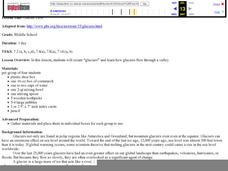Curated OER
Glacier Flow
Young scholars investigate how glaciers flow through valleys. They answer discussion questions, and in small groups create a simulation of a glacier using a plastic shoe box, water, cornstarch, and pebbles, evaluating their results on a...
National Park Service
Glaciers and Water
Explore the amazing power of glaciers with a hands-on earth science experiment! After first learning basic background information, learners go on to create their very own chunks of frozen water and gravel in order to...
Polar Trec
Is There Salt in a Glacier?
What can conductivity tell us about a glacier? Groups analyze glacial melt to determine salt content through an analysis of the pH and conductivity measurements of two samples. Groups then determine the source of the salts.
Curated OER
Glacier Climbing
Students discover where glaciers exist and how they move. In this glacier lesson, students work in groups to create a glacier in a replica valley and observe its properties.
Curated OER
Glacier Dynamics
Students create flubber glaciers. In this glacier dynamics lesson, students experiment factors that may affect glacier speed. Factors include slope, ice temperature, and basal conditions. Students develop hypothesis, conduct experiment,...
Curated OER
The Blackfeet of Glacier National Park
Students research an aspect of the Blackfeet tribe in Glacier National Park. They work together to create a presentation that is representative of their culture. They share their presentation with the class.
Curated OER
Educating K-12 Students about Glacier Dynamics in a Changing Climate
Students determine which of the following parameters, slope, ice, temperature or basal condition affects the glacier speed the most. They create their own experiment to test what influences glacier speed and temperature of the ice.
Curated OER
A Glacier Ran Through It
Students learn basic geological concepts while researching how ice age floods sculpted the plateau of the Columbia Basin. They synthesize their learning by creating annotated illustrations of the geological principles they studied.
Curated OER
Go Glacier Go!
Learners create a model of a glacier and observe how it moves. In this landforms lesson, students learn what a glacier is, build a model glacier and observe how it moves in a manner that more closely resembles a liquid than a solid.
Curated OER
Glacier Slide
Students conduct an experiment. In this glaciers activity, students learn about glaciers and then perform an experiment to show how glaciers shape the landscape around them. Students draw a picture in their journals to...
NOAA
Where Have All the Glaciers Gone?
What happens when ice melts? Well ... water happens. When that melting ice is a glacier, the amount of water that results produces change throughout the world. Middle school science sleuths uncover the truth about global...
Curated OER
Glacier Presentations
Students research news articles relating to global climate change. In this earth science lesson, students create a news broadcast using the information they gathered. They present this in class and each student gives their peer...
Curated OER
Fastest Glacier
Students compare and contrast continental ice sheets and a glacier. They discuss how glaciers form. Students research the average winter and summer temperatures for their area. They predict what might happen to the Greenland...
Curated OER
Glacier Climbing
Students discuss glaciers and the current distribution of glaciers around the Earth. They create simulated glaciers using cornstarch, shoeboxes, water, and pebbles.
Curated OER
The Living Earth
Students discuss glaciers and write a definition for a glacier as a class. After discussion, they participate in an activity that demonstrates how glaciers can cause dramatic changes and create new landforms. Groups discuss their...
Montana State University
Ice in Action
Make your own bite-size glacier! A resource teaches about the formation and melting of ice. Activities include videos, a hands-on activity where your pupils build glaciers, and a photographic analysis to teach individuals the chilling...
Curated OER
The Bear Facts
Students explore various kinds of bears and gather information about them. In this research and habitats lesson, students chart their bear information on large posters with illustrations of their bears. Students map the...
Curated OER
Winter-time Temps
Students measure temperature and become aware the the temperature above and below the snow is different. In this winter temperature lesson, students measure temperatures to find variation based on how the snow is packed. Students...
Curated OER
Gliding Glaciers
Glaciers are the star of the show in this Earth science lesson. In it, learners gain an understanding of how glaciers are formed, how they move, and what types of landforms they create. This lesson plan is written in the classic format,...
Curated OER
Forecasting the Path of Mudflows
Students watch a demonstration to introduce them to the consistency of mudflows and how they move. In groups, they compare and contrast volcanic avalanches and mudflows. They create their own model of a volcano, simulate how it erupts...
Curated OER
Volcanoes!: Forecasting the Path of Mudflows
Students construct a mockup of a volcano by crumbling up newspapers and piling them into the shape of a volcano. They place a tarp over the newspapers making sure the tarp is large enough to simulate a flat area at the volcano's base....
Curated OER
Habitat is Home
Students complete a picture to show things found in their homes. In this habitat lesson plan, students discuss and make a class picture of an animal habitat and its four basic needs. Students sing a song. Students create...
Curated OER
Snapshot Day Definitions and Activities
Here is a document full of teaching notes on water quality and bodies of water that you can use in your ecology curriculum. It has information specific to the Hudson River area, but can easily be adapted to any local body of water....
Curated OER
Forest Communities
Young scholars identify tree specimens. In this tree specimens lesson, students collect different parts of a tree from the areas around the school or their home. They then work in groups to create booklet that identifies tree...























